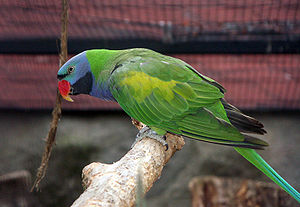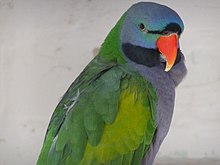Chinese Parakeet
| Chinese Parakeet | ||||||||||||
|---|---|---|---|---|---|---|---|---|---|---|---|---|

( Psittacula derbiana , adult male) |
||||||||||||
| Systematics | ||||||||||||
|
||||||||||||
| Scientific name | ||||||||||||
| Psittacula derbiana | ||||||||||||
| ( Fraser , 1852) |
The Chinese parakeet ( Psittacula derbiana ) is a parrot species from the genus of the noble parakeet that is widespread in Asia . The species is rarely kept in captivity because of its size and noisy way of life; the population in its natural range is classified as stable.
distribution
The distribution area of the Chinese Parakeet extends over the southwest of the People's Republic of China and southeastern Tibet to the adjacent north of India . The species mainly inhabits mountain forests between 1200 and 4000 m above sea level. In winter the swarms also move to lower altitudes.
features
P. derbiana is one of the most colorful species of the noble parakeet ( Psittacula ). With a total length of up to 50 cm, both sexes show an intense green color on the upper side of the body. The head is bluish-purple in color, a black band extends between the eyes above the upper beak root . The upper bill is bright red in adult males, while females show a black upper bill, while the lower bill is black in both sexes. A wide, black throat band separates the violet head from the violet chest and stomach area. In addition to their black upper bills, the females also differ from adult males by their significantly paler color. Young animals show initially a reddish, later a black beak color if the overall color is pale. The plumage is colored by the age of 3 years.
No subspecies of the Chinese Parakeet have been described.
behavior
Like most parrot species , Chinese parakeets are very social animals. In its natural habitat, the species forms medium-sized swarms of up to 50 individuals that seek feeding and sleeping places together. The swarms are particularly at maturity of barley and maize frequently encountered when foraging near human settlements, where they partially with groups of wild collar parakeets gather and cause sometimes great damage in agriculture. The Chinese parakeet's diet consists mainly of seeds, buds, berries and other fruits. The calls of the species are very loud and are described as long, metallic and harsh sounding screams.
Reproduction
The species reaches sexual maturity at around 2–3 years of age . The males perform a characteristic courtship ritual in which they stride conspicuously and fan out their tail feathers on both sides. With a vibrating lower beak and conspicuous pupillary contractions, the courting male bows before the female before copulation occurs. Mutual feeding of the partners was also observed. The Chinese parakeet breeding season begins in June. During this time, the pairs occupy tree hollows, often in poplars, which serve as nests and in which the young hatch from the 2-4 eggs after about 25 days of breeding. During the breeding season and the first 10 days after hatching, the female almost never leaves her nest and is provided with food by her partner. The young animals leave the nest after 7–9 weeks, but are fed by their parents for another 2–3 weeks before they are released into self-employment.
literature
- K. Kolar and K. Spitzer: Large parakeets: keeping, behavior and breeding. Ulmer Verlag 1995, ISBN 3-8001-7326-3
Web links
- Psittacula derbiana in the endangered Red List species the IUCN 2008. Posted by: BirdLife International, 2008. Accessed on December 21 of 2008.
- Videos, photos and sound recordings of Psittacula derbiana in the Internet Bird Collection
